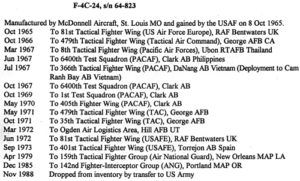F-4C Phantom II History
The workhorse of Vietnam was the F-4 Phantom II. It was used in a number of combat roles.
Very few F-4 squadrons remain. Only in reserve units, like the “Wild Weasels”, the F-4 will soon disappear from active service, being replaced by the more agile, faster, and electronically superior F-16s and F/A-18s.
Pacific Coast Air Museum´s F-4 was an Air Force jet. After its service life was over, the jet was assigned to the Sierra Army Depot, on Highway 395, north of Reno. The jet was going to be used as a “crash and burn” victim, being torched for fire fighters to practice putting out aircraft fires. The Army never put one match to it. The aircraft sat for several years, along with a twin F-4, way out in the middle of nowhere on the base. Army officials finally decided to get rid of the aircraft and looked for places to dispose of them.
As fate would have it, two museums got word of the aircraft and applied for acquisition. Pacific Coast Air Museum was one of the museums selected to receive one of the aircraft.
In 1994, crews of Pacific Coast Air Museum members spent many hours on the Army base, in desolate conditions, taking the F-4 apart. It was very hard as the aircraft was built to take a lot of abuse, and was not easy to dismantle.
Slowly, pieces began to arrive, and other crews, as well as the disassembly crews, put it back together, for a permanent home at Sonoma county. The history of the aircraft is being researched.

F-4C Phantom II Specifications
Length
63 ft 0 in (19.2 m)
Wingspan
38 ft 4.5 in (11.7 m)
Height
16 ft 6 in (5.0 m)
Wing area
530.0 sq ft (49.2 sq m)
Empty weight
30,328 lb (13,757 kg)
Loaded weight
41,500 lb (18,825 kg)
Max. takeoff weight
61,795 lb (28,030 kg)
Two: Pilot in front, and a “Guy In Back” or “GIB”, officially called the Weapon System Officer or WSO, shortened to “wizzo.” Also called “backseater”.
Maximum speed
Mach 2.23 (1,472 mph, 2,370 km/h) at 40,000 ft (12,190 m)
Cruise speed
506 kn (585 mph, 940 km/h)
Combat radius
367 nmi (422 mi, 680 km)
Ferry range
1,403 nmi (1,615 mi, 2,600 km) with 3 external fuel tanks
Service ceiling
60,000 ft (18,300 m)
Rate of climb
41,300 ft/min (210 m/s)
Two General Electric J79-GE-17A axial compressor turbojet jet engines
Sparrow Missiles, plus four AIM-9 Sidewinders. In addition, up to 7257 kg (16,000 lbs) of assorted weapons.
APQ-72 Fire Control Radar
Tony Sarganis

